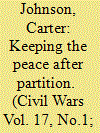| Srl | Item |
| 1 |
ID:
144444


|
|
|
|
|
| Summary/Abstract |
This paper examines partition as a solution to ethnic civil wars and modifies the ethnic security dilemma, suggesting that strong state institutions are more important than demographically separating ethnic groups to achieve an enduring peace. The paper starts with a puzzle: if ethnic separation is required for peace, how do some partitions that leave minorities behind maintain peace? The paper compares post-partition Georgia–Abkhazia, which experienced violence renewal within five years of the partition, with post-partition Moldova–Transnistria, which maintained peace. Both countries had ‘stay-behind’ ethnic minorities. The paper also disaggregates and compares the territories within post-partition Abkhazia, which contain ethnic Georgians: Lower Gali experienced violence while neighboring Upper Gali did not. The paper argues that state institutions create an incentive for ethnic minorities to collaborate with the state, regardless of minority preferences, and this helps maintain peace. However, preferences become important where institutions are weak and members of the ethnic minority have the opportunity to defect; this increases the likelihood of violence. The results build on the ethnic security dilemma by specifying micro-mechanisms and challenging the theory's reliance on intransigent ethnic identities in explaining the causes of post-partition violence.
|
|
|
|
|
|
|
|
|
|
|
|
|
|
|
|
| 2 |
ID:
147328


|
|
|
|
|
| Summary/Abstract |
This article discusses factors that shaped the initiation and escalation of the Jarso–Girhi violence that occurred two decades ago. The data required for the study were collected from community leaders, ordinary members of the communities, and administrative and political officers. The data were collected through one-on-one interviews, focus group discussions and field observations. The study shows that the inter-communal violence was the result of convergence and interaction between historical, ethnopolitical, sociocultural and psychosocial factors. The study reveals the impact of ethnically based mobilization in stoking underlying communal cleavages, in breaking trust and cooperation and in escalating communal unrests. The violence featured dynamics of ethnic competition and destruction in which ethnic competitors failed to minimize mutual harms and maximize mutual gains.
|
|
|
|
|
|
|
|
|
|
|
|
|
|
|
|
| 3 |
ID:
098349


|
|
|